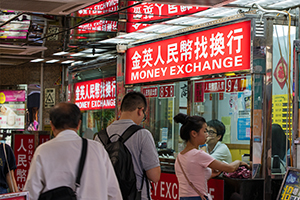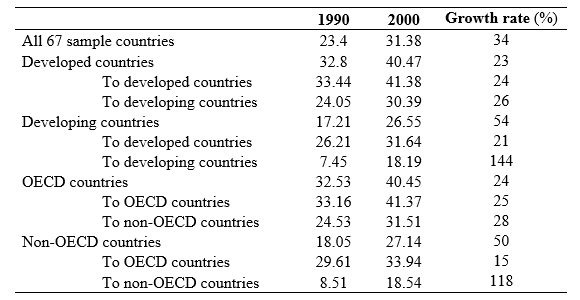 While more than two-thirds of skilled migrants are directed to the United States, the United Kingdom, Canada, and Australia, they come from more than 100 countries. Skilled emigration opens many indirect general equilibrium questions in the source country. Does skilled emigration matter for volatility in real exchange rates?
While more than two-thirds of skilled migrants are directed to the United States, the United Kingdom, Canada, and Australia, they come from more than 100 countries. Skilled emigration opens many indirect general equilibrium questions in the source country. Does skilled emigration matter for volatility in real exchange rates?
In a recent study, Ouyang and Paul (2018) look at the relationship between skilled emigration and real exchange rate movements in source countries. Building on a simple analytical model, they argue for two possible channels of causality. If the Law of One Price holds, then skilled emigration appreciates the real exchange rate through the “spending effect” and the “resource allocation effect,” which are analogous to the remittance-based Dutch disease effect. The second channel is based on a pricing-to-market model, where local wages affect the price-setting behavior of firms and, unlike the first channel, the pricing-to-market model allows pass-through for both external (relative prices of traded goods) and internal (relative prices of traded to nontraded goods) prices assuming possible violations of the Law of One Price.
Table 1 provides evidence on the level and growth of the skilled emigration ratio for the period 1990–2000 across regions. The skilled emigration ratio is estimated as a percentage of total emigration. For the full sample of 67 countries, the average skilled emigration ratio is estimated to be 23.4% and 33.4% in 1990 and 2000, respectively. The growth of averagely skilled emigration during this period is estimated to be about 34%. A comparison across regions reveals different migration trends. While skilled emigration ratios are high in developed and Organisation for Economic Co-operation and Development (OECD) countries, these figures are mostly driven by migration within the developed or OECD groups of countries. The average skilled emigration ratio from developed to developing countries is significantly lower than that of developing to developed countries. However, there is evidence of catching up, as the growth rate of the average skilled emigration ratio is recorded as highest (almost 144%) for developing countries, especially for south-south migration corridors. Overall, the average growth of skilled emigration is high during the period of our analysis and could be a potential factor behind the movements in exchange rates.
Table 1: Skilled emigration ratio

(% of total emigration among sample countries)
OECD = Organisation for Economic Co-operation and Development.
Source: Authors’ calculation based on Artuç et al. (2015) data on bilateral skilled emigration.
The authors also provide cross-country empirical evidence from 67 countries showing that net skilled emigration appreciates the bilateral real exchange rates in the source countries. The details can be found here. To identify the potential channels of causality, they decompose the real exchange rate into two sets of relative prices, viz. the relative price of traded goods between economies (external prices) and the relative price of traded and nontraded (internal prices) goods within each country. The skilled emigration elasticity of the real exchange rate is estimated to be in the range of between 0.6 and 0.8 across the country samples. Overall, the internal (relative price of traded to nontraded) price channel provides a stronger pass-through to the skilled emigration effect on the real exchange rate. The outcomes are robust across different levels of skilled emigration and alternative model specifications.
Although the main goal of the paper was to provide evidence for an alternative channel linking skilled emigration and real exchange rates, the authors acknowledge the possibility of a potential negative labor supply effect due to an increase in remittances. With an increase in reservation wages due to remittances, there could be alternative wage effects, and in such cases, one needs to identify and separate the wage channel effect. In addition, an almost 54% growth in the skilled emigration rate between 1990 and 2000 in developing countries warrants a more refined study of skilled emigration disaggregated by gender, industry, and occupation group.
Read the working paper here.
_____
References:
Artuç, E., F. Docquier, Ç. Özden, and C. Parsons. 2015. A Global Assessment of Human Capital Mobility: The Role of Non-OECD Destinations. World Development 65: 6–26.
Ouyang, A. and S. Paul. 2018. The Effect of Skilled Emigration on Real Exchange Rates through the Wage Channel. Journal of International Money and Finance 89: 139–153.








Comments are closed.